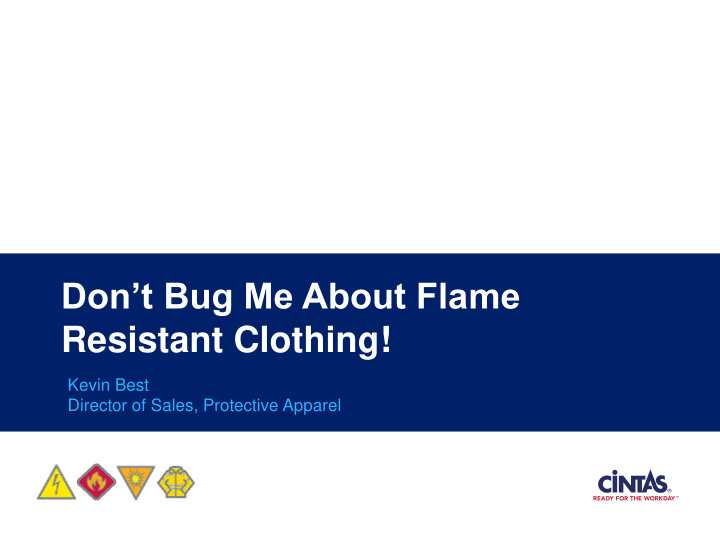



Don’t Bug Me About Flame Resistant Clothing! Kevin Best Director of Sales, Protective Apparel
Don’t Bug Me! • “82% of safety professionals have observed workers in their organizations failing to wear required PPE during the previous year.” Source: Alarming Number of Workers Fail to Wear Required Protective Equipment, Kimberly Clark Professional, 2012
What if This Was YOU?
Raise Your Hand if…. • Uncomfortable • Too hot • Blamed for decreased productivity or an inability to perform tasks • Unavailable near the work task • Ill-fitting • Unattractive looking Source: Alarming Number of Workers Fail to Wear Required Protective Equipment, Kimberly Clark Professional, 2012
Evolution
FR History FR History
How FR Properties are Achieved • Molecular • Fiber • Fabric
FR Clothing Today • Inherent: – By its very nature, as a core property .” • Treated: – Chemical engineering that imparts FR properties
Perception vs. Reality “Inherent” “Treated” • Doesn’t wash out • Longevity depends on chemicals used • Number of launderings doesn’t • Surface treatment matter • Repeated launderings • FR properties remain affect FR properties for the life of the • Eventually washes out garment
Know Your FR Natural What should we call a fabric that is: – 35% Aramid 65% FR Modacrylic? – 50/50 FR Cotton and FR Aramid Modacrylic? • Believe it or not, they are all marketed as “Inherent”.
Issues for End Users Regarding “Inherent” and “Treated”….. • Not actually textile terms • Only relevant 25 years ago • Clearly create confusion • No established rules or guidelines
What Do End Users Want? • Style • Breathability • Moisture-wicking Capabilities • Certification • Selection • Brand Source: Alarming Number of Workers Fail to Wear Required Protective Equipment, Kimberly Clark Professional, 2012
Common Certifications • UL Compliant – USA- NFPA 2112 – Canada- CGSB 155.20 • Arc Rating – ASTM F1959-06 • Anti-stat – EN 1149-3&5 • Visibility – ANSI 107
What’s New in the Market? • Arc Rated vs Flame Resistant • Moisture management • Anti-Microbial • Chemical splash • Anti-stat • Cooling effect • Garment wash
New Trends Did you know: • 13% of burns • Non-FR can burn/melt • Moisture wicking
Colorfastness • The carrot = Solution Dyed • The radish = Piece Dyed
Weight to ATPV Ratio 10 10.1 9.5 Minimum 8 8.5 requirement for 8.4 8.4 Class II 7.3 6 5.6 GlenGuard - 6.4 Minimum Tecasafe - 7.0 4 4.5 requirement for Protera – 7.0 GlenGuard - GlenGuard - Class I Nomex IIIA - Indura - 7.0 Nomex IIIA 2 4.5 5.3 6.0 4.5 0
Defining Comfort? AATCC 195-2012 0.9 Excellent 0.8 >0.8 0.8 GlenGuard 6.4 0.7 0.7 Very Good GlenGuard 4.5 0.6 0.6 0.6 0.6 0.6 – 0.8 0.6 GlenGuard 5.3 Good 0.5 Tecasafe 700 0.4 – 0.6 0.4 Tecasafe 580 0.4 0.3 UltraSoft 7.0 Poor 0.3 0.2 – 0.4 Nomex 6.0 0.2 Nomex 4.5 Very Poor 0.1 0 – 0.2 0 Fabrics Tested
Case Study • Fade resistant solution dyed fabric • Button-down banded collar • Chest pockets with button close flaps, pencil stall left • Double and triple needle seam construction • Tailored sleeve placket with button closure and two button adjustable cuff • GlenGuard’s Wickzz ™ proprietary finish accelerates the absorption, dispersion and evaporation of moisture content
Conclusions • No perfect fiber/fabric • Focus on FR engineering • Look at the labels! • Review the warranty • Ensure FR for life • Wear trials • Keep bugging us!
Thank you! Kevin Best Director of Sales, Protective Apparel
Recommend
More recommend